Report Highlights. Pets, pet products, and pet care are all part of a $103.6 billion national industry; 40.5% of revenue is from food and treats alone.
- The pet industry grows by 11.6% every year.
- The average pet-owning household spends $1,120 per year on their pets.
- 2-in-3 American households include at least one pet.
- Two (2) corporations consume 49% of the pet industry’s market share.
- Globally, the pet industry is worth $232 billion.
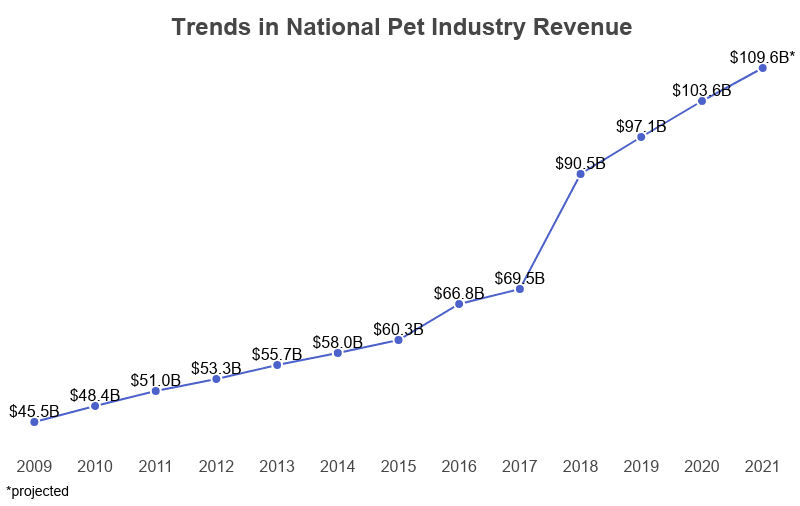
Pet Industry Statistics
The pet industry is one of the most massive sectors of the American economy, with many more years of growth potential. While some markets may lag, statistics indicate that economic downturns do little damage to the industry as a whole.
- Americans are responsible for 44.7% of the global pet market.
- 67% of households nationwide keep pets.
- Over the last decade, domestic industry revenue has grown at an annual rate of 11.6%.
- The most profitable pet supply company is PetSmart, Inc. with a 34% market share.
- PETCO is the second-largest with a 15% market share.
- $23,400–$27,200 is the average lifetime cost of raising a pet.
- U.S. pet owners spend a collective $42.0 billion on pet food and treats annually.
- Pet care service sales, such as grooming and doggie day care, doubled over 10 years but declined 47% from March to September 2020 during COVID-19 quarantines.
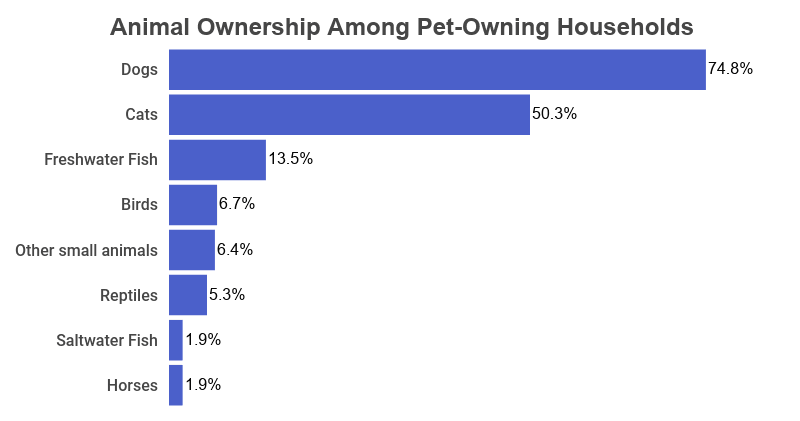
Technology in the Pet Industry
Online pet-related purchases lead eCommerce markets, and more users make first-time purchases every day. Tracking and identification technology is the fastest rising product type.
- 13% of pet-related sales are made online.
- Chewy.com is the leading pet specialty eTailer with $3.5 billion in annual sales, or
- 20% of pet owners who buy supplies online purchased from Chewy in the last year.
- Amazon and its third-party retailers made 35% of online pet sales.
- Technology is a growth market, seeing a 14% increase in sales each year.
- $1.6 billion is the market share for pet-related technology.
| Expenditure | Cost per Dog | Cost per Cat |
|---|---|---|
| Surgical Vet Visits | $426 | $214 |
| Food | $259 | $228 |
| Boarding | $229 | $120 |
| Routine Vet Visits | $212 | $160 |
| Treats | $76 | $58 |
| Grooming & Grooming Products | $73 | $43 |
| Vitamins | $58 | $54 |
| Toys | $48 | $31 |
Pet Food Industry Statistics
The largest sub-market in the industry, pet food sales account for 39.3% of the global market. Owners drive the industry, demanding higher quality products and more accountability among pet food manufacturers and suppliers.
- Over 500 pet food manufacturers produce the 3.3 billion pounds of pet food American dogs and cats consume annually.
- 2 pounds of food per month is the average companion animal’s rate of consumption.
- 55% of consumers buy their pet’s food from pet supply stores.
- 85% of consumers think pet food companies aren’t as transparent as they should be about ingredients and their sources.
- 44% of pet owners say buying healthy food for their pet is more of a priority than buying healthy food for themselves.
- 53% of pet owners take just as much care to purchase healthy food for their pet as they do for themselves.
- 21% of pet food sales are treats.
- Pet owners spend 4 times as much on food and treats as they do on general pet supplies.
- Mars Petcare Inc., the largest pet food corporation, is worth more than $18 billion.
- The success rate of pet food companies has created a boom in trendy boutique and specialty pet food products.
- The U.S. exports $1.5 billion worth of pet food each year, more than any other world nation.
- U.S. pet food exports to China increased 88% in a year, from 2018 to 2019.
- Thailand imports more pet food than any other world nation.
- The East Asian pet food market is worth $11 billion.
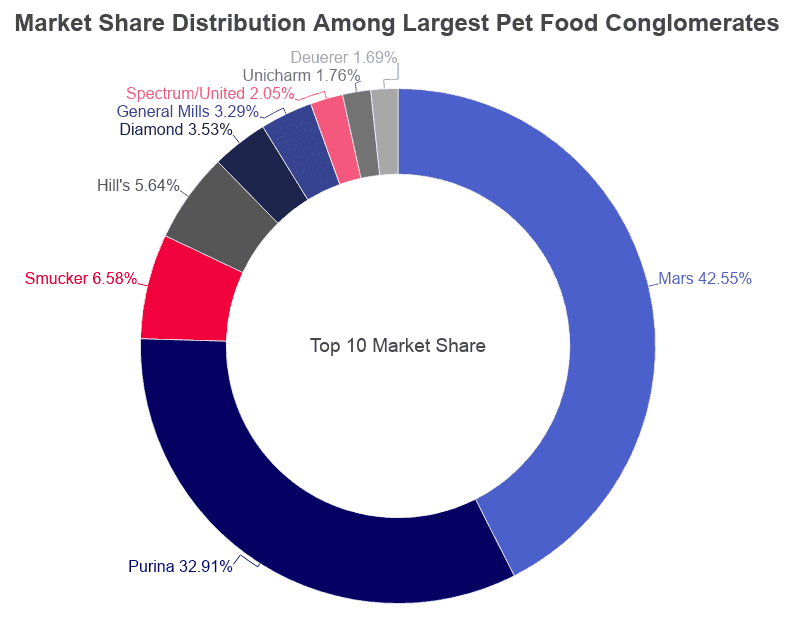
Pet Healthcare Industry Statistics
Growth in the pet healthcare industry outpaces that of human healthcare. Pet healthcare includes veterinary services, pharmaceuticals, over-the-counter medications, behavioral therapies, calming therapies, spa treatments, vitamins, allergy treatments, and more.
- The U.S. pet healthcare industry makes up about 33% of the global market.
- It serves as many as 10 billion companion animals worldwide.
- Pet healthcare is a 10 billion dollar industry, and its total economic impact is estimated to be $54.8 billion
- 19,400 jobs with $1.1 billion in wages are included in that economic impact.
- 5% is the annual growth rate of the pet healthcare industry.
- 1% of the U.S. pharmaceutical market goes to pet healthcare.
- After pharmaceuticals, flea and tick medications are the second-most common expenditures.
- 29% of the market is flea and tick medications
- Pet owners spend an average of $81 on tick and flea medication for each pet.
- Toward the end of a pet’s life, its owner’s healthcare expenditures skyrocket.
- High-income pet owners spend over three times as much of their household’s budget on their pet’s health care than low-income owners do.
- Animal health manufacturers spend more than twice as much on research and development as they do on manufacturing costs.
- The U.S. exports $2.5 billion worth of pet healthcare products.
- 10% of pet medications are imported.
- Imports are worth $1 billion, giving the United States a $1.5 billion trade surplus in the pet healthcare industry.
- The industry provides federal and state governments with $38.1 million in taxes.
- The indirect economic impact, which includes jobs in related industries and industries that depend on pet healthcare, may be as high as $548 billion.
Veterinary Industry Statistics
Most pet healthcare expenses go to veterinary services. Vet techs perform many of the same duties that nurses do in a regular doctor’s office and are similarly in demand. Job growth within the industry is projected to continue.
- 27% of all pet-related expenditures are for vet care.
- The average annual vet bill ranges from $100 for birds to $260 for dogs and $550 for horses.
- Routine physicals and vaccinations are the most commonly performed services.
- Surgical expenses have the heftiest price tag, followed by emergency visits.
- Pet owners pay a collective $30.2 billion in veterinary bills each year.
- 60% of veterinary workers are vet techs, veterinarians, or animal caretakers and lab assistants.
- There are more veterinarians nationwide than there are medical doctors.
- 10% of pet owners purchase their pet’s food from their veterinarian.
- 44% of pet owners say their veterinarian is their main source of nutrition information (compared to 25% of pet owners who cited the internet as their primary source for pet nutrition information).
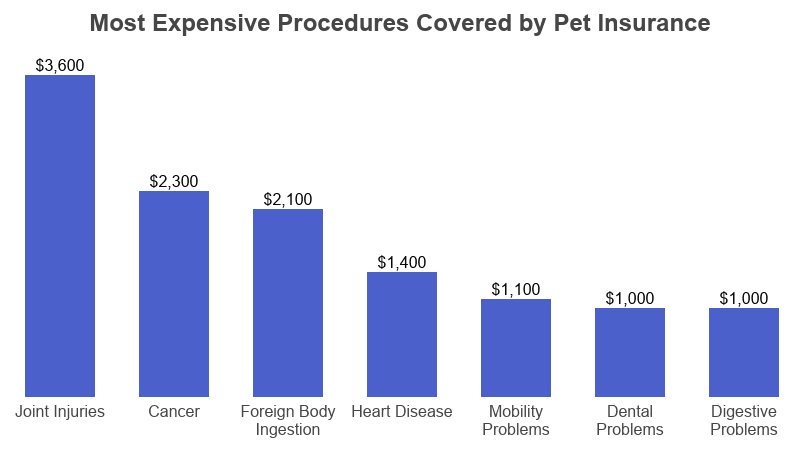
Pet Insurance Industry Statistics
Pet insurance is still not as popular among American pet owners as it is elsewhere in the world. It is, however, one of the fastest-growing sub-markets within the national and global pet industries.
- The pet insurance industry launched in 1982 when Veterinary Pet Insurance (now part of Nationwide) became the first pet insurance company.
- Pet insurance is growing by as much as 16.8% each year.
- With just 2.1 million or 1.6% of pets covered, the pet insurance industry is still in its infancy.
- Premiums average $140 for cats and $190 for dogs.
- High-end rates are $340 for cats and $540 for dogs.
- Premium rates grew by 23.2% in five years.
- 81% of pet insurance policies are combined accident and illness coverage for dogs.
- 15% of pet insurance policies cover cats and other pets.
- While most companies only cover dogs and cats, some offer policies for rabbits, birds, reptiles, and pot-bellied pigs.
- 250 U.S. companies include pet insurance in 80,000 employee benefit packages.
- In Sweden, over 30% of pets are insured.
- Canada’s pet insurance industry nearly doubled its profits in five years, from $91 million to $161 million.
- The most common claim among insured pets is for non-specific GI illnesses.
- Cancer and unspecified lameness (limping) are the second- and third-most common claims, respectively.
- 1-in-3 pets need unexpected veterinary care each year.
- $800-$1,500 is the average cost of emergency vet care.
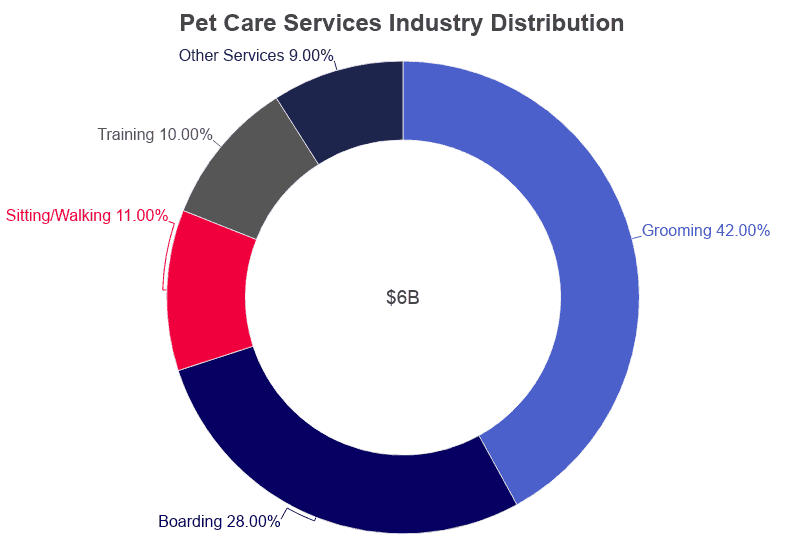
Pet Care Service Industry
Pet-sitting, boarding, and grooming are crucial services for many pet owners. Grooming may be essential for a pet’s health and well-being, and high-income earners are willing to pay for luxury.
- 8% of the pet industry is made up of grooming and boarding services alone.
- The industry has grown more than 60% since 2007.
- 42% of the pet care service industry is composed of grooming services.
- 18,700 people work just in grooming and/or boarding services.
- Pet-sitting/walking is the least lucrative pet care service.
- Animal training services are some of the most lucrative sectors and account for 10% of the pet care service industry.
- Animal trainers and businesses each earn an average of $373,000 annually.
- Just under half of all pet care service workers are self-employed.
- Excluding self-employed workers, 111,384 employees populate the pet care service industry.
- Pet care service jobs have grown exponentially in the past decades, outpacing job growth in every other pet industry.
- Most pet care workers are employed by companies with fewer than 20 people.
- Over 100,000 companies are active in this market.
- 30% of pet grooming expenditures go toward supplies.
- Most grooming expenses go toward shampoos and conditioners.
- A steady 4.3% annual growth rate in pet grooming and boarding services appears to have stalled.
- Some experts say the market will see a 47% drop for the 2020 fiscal year.
Illegal and Black Market Industries
The puppy mill and exotic pet industries are two of the most active pet-related black markets. While the general public grows more informed, most people still aren’t aware of how much puppy mills supply the greater pet industry. Characterized by filth and disease, most active puppy mills are illegal operations, with many advertising themselves as “breeders.”
- 90% of puppies sold in stores come from mills.
- Over 4 million puppies are born in mills every year.
- About half of them survive long enough to make it into pet stores.
- Only about 30% of puppy mills are licensed.
- 70% of pets are purchased from a breeder or pet store.
- In addition to federal bans on certain exotic pets, more than half of U.S. states have banned exotic pets either in full or in part.
- Exotic pets require specialized care, including a veterinarian who is familiar with the animal, a suitable habitat, and foods that may not be available in pet stores.
- Smugglers traveling with illegal animals will not prioritize the animal’s health or comfort.
How Owners Drive the Pet Industry
Products may be manufactured for pets, but they’re marketed to pet owners. Owner demographics and spending habits drive the market. Younger pet owners, for example, are more likely to buy pet supplies online.
- After dog- and cat-owning households, households with freshwater fish were the third-most common, followed by bird-owning households.
- While more households include at least one dog, more cats than dogs are kept as pets, with cat owners averaging 1.8 cats per household.
- Dog-owning households keep an average of 1.6 dogs.
- Freshwater fish owners average 13 fish per household.
- 42% of all pets are freshwater fish.
- 35% of pet owners are under 40, making them the leading pet-owning age demographic.
- 80% of these under-40 pet owners own dogs.
- Less than 50% own cats.
- 81% of dog owners buy their dog a Christmas present.
- 21% of holiday pet sales are purchased by friends and family of pet owners.
- 36% of dog owners give their dog a birthday present.
- High-income pet owners spend as much as 60% of pet expenses on pet accessories, such as costumes, furniture, and even doggy cologne.
- 27% of pet owners have paid for professional photos of their pets.
- Over 135 million cats and dogs live in the United States.
- 200-300 million animals are kept as pets.
- Pet ownership rates increase with household income.
- Among households with a combined income of more than $80,000, 60% include pets.
- Among households with a combined income of less than $20,000, 36% include pets.
- 60% of people who lived in homes with four or more bedrooms own pets.
- 18% of people who live in homes with no bedrooms, such as studios or lofts, own pets.
- People who live in rural areas are 43% more likely to own pets than urban dwellers.
- Cat ownership in China increased 131% in four years, from 2015 to 2019.
- During that same period, cat ownership increased 102% in Korea and 53% in Taiwan.
Sources
- Pet Industry Market Size & Ownership Statistics
- Pet Industry Trends, Growth & Statistics in 2021 and Beyond: Unleashing Your Ecommerce Pet Marketing Strategies
- U.S. Census Bureau, Historical Household Tables
- American Veterinary Medical Association, U.S. Pet Ownership Statistics
- Pet Care Industry Analysis 2020 – Cost & Trends
- 10 Ridiculous Pet Products We Can’t Believe Really Exist
- Cats or Dogs: Which is More Expensive?
- A Guide to Worldwide Pet Ownership
- A Policy for Fluffy: Pet Insurance is a Small Industry–But It’s Poised for Big Growth in the U.S.
- Despite Pet Industry’s Strengths, Expected Decline in Sales for 2020
- Pet Grooming and Boarding – 2020 U.S. Market Research Report with Updated COVID-19 Forecasts
- Animal Health Institute: The Animal Health Industry
- Human and Pet Health-Cost Trends are Strikingly Similar
- Is American Pet Health Care (Also) Uniquely Inefficient?
- Census, Spending on Pet Care Services Doubled in the Last Decade
- Unique Opportunities for Increased U.S. Exports of Pet Food to East Asia Remain Despite COVID-19
- American Feed Industry Association, About the Industry
- Survey Examined Dog Owners’ Pet Food Beliefs
- Top Pet Food Companies Current Data
- Pet Franchise Industry Overview
- Facts + Statistics – Pet Statistics
- CNBC, Are You Prepared for a Vet Emergency? Most Americans Are Not
- Grandview Research, Pet Wearable Market Size, Share & Trends Analysis Report By Technology (RFID, GPS, Sensors), By Application (Identification & Tracking, Medical Diagnosis & Treatment), By Region, And Segment Forecasts, 2020 – 2027
- Allied Market Research, Pet Grooming Products Market by Type (Shampoo & Conditioner, Comb & Brush, Clippers & Scissors, and Others) and Distribution Channel (Retail Store, Online Platform, Supermarket/Hypermarket, and Others): Global Opportunity Analysis and Industry Forecast, 2018 – 2025
